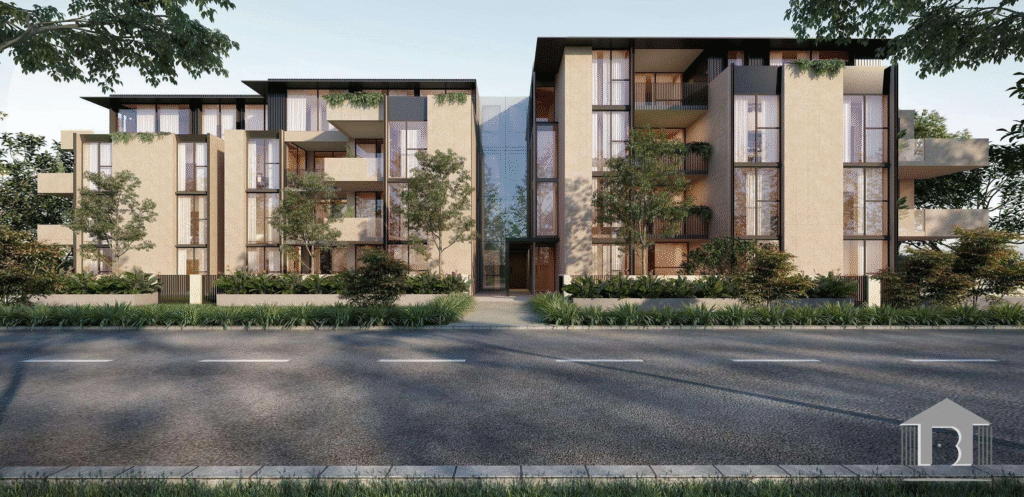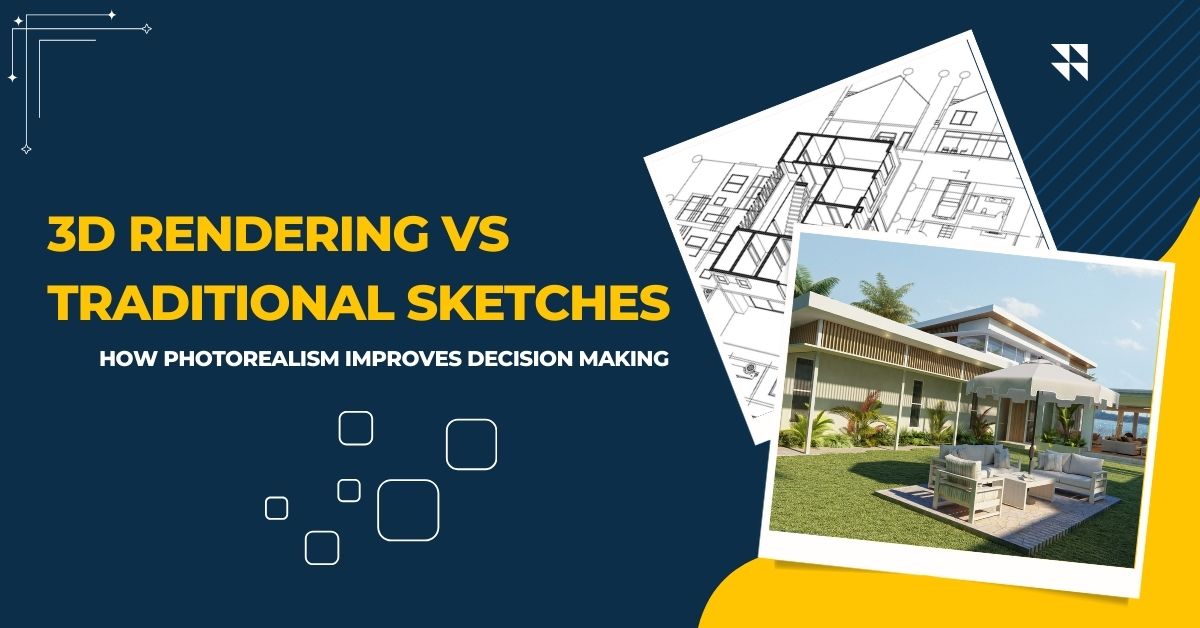In the world of design, whether it’s architecture, interiors, or product visualization, communicating ideas clearly has always been the key to success. For decades, Traditional Sketches served as the backbone of design communication: simple lines, shades, and perspectives used to express creativity and concepts. However, with the evolution of technology, 3D Rendering has transformed the way professionals present and refine their ideas.
We’ve seen first-hand how Photorealistic 3D Rendering is changing the decision-making process for clients and designers alike. This blog explores the differences between 3D Rendering vs Traditional Sketches and highlights how photorealism improves clarity, confidence, and outcomes in design projects.
What Are Traditional Sketches?
Traditional sketches are hand-drawn or digital illustrations created by designers to visualize an idea. They have long been used to:
- Convey the basic form, layout, and proportions of a design.
- Provide a conceptual direction without going into detail.
- Allow designers to quickly experiment with multiple variations.
For example, an architect might sketch the exterior outline of a building, while an interior designer may create a quick room sketch showing furniture placement.
While sketches are fast and cost-effective, they often lack precision, detail, and realism, which can sometimes leave clients guessing about the final outcome.

What Is 3D Rendering?
3D rendering is the process of creating lifelike digital images or animations of a design using computer software. Unlike sketches, renderings use advanced tools to simulate real-world details such as lighting, textures, shadows, colors, and materials.
Types of 3D rendering in design include:
- Architectural 3D Rendering – For buildings, exteriors, and layouts.
- Interior Design 3D Rendering – For rooms, furniture, finishes, and décor.
- 3D Product Rendering – For showcasing products with photorealism.
- Virtual Tours & Walkthroughs – Interactive experiences that bring spaces to life.
The result? A photorealistic image that looks almost identical to a photograph of the finished project.

3D Rendering vs. Traditional Sketches: The Key Differences
| Aspect | Traditional Sketches | 3D Rendering |
| Clarity | Conceptual, abstract, open to interpretation | Photorealistic, highly detailed, crystal clear |
| Speed | Quick for rough ideas | Slower initially, but detailed once complete |
| Client Understanding | May confuse non-technical clients | Instantly understandable, no guesswork |
| Revisions | Harder to update consistently | Easy to modify digitally |
| Decision-Making | Based on imagination, higher risk of misalignment | Informed decisions with near-real visuals |
| Technology Level | Minimal paper or digital drawing tools | Advanced—software like 3ds Max, V-Ray, Blender |
Why Photorealism Matters in Design Decision-Making
1. Eliminates Miscommunication
One of the biggest challenges in traditional sketches is the gap between designer vision and client understanding. Clients who aren’t used to reading sketches often struggle to imagine the final outcome.
With Photorealistic 3D Rendering, this problem disappears. Clients see exactly how a design will look, from the color of the walls to the shine on the flooring, enabling clear communication between all stakeholders.
2. Builds Client Confidence
Decision-making is often emotional. A hand sketch may leave doubts: Will this really look good?
But when clients see a Photorealistic Rendering of their future home, office, or product, it creates trust and excitement. They can visualize themselves in the space, leading to faster approvals and stronger confidence in the project.
3. Saves Time and Cost in Revisions
Sketches often require multiple rounds of re-drawing to adjust layouts or details. This consumes time and may still leave clients unsure.
By contrast, 3D Rendering Software allows designers to quickly update layouts, colors, or textures. Want to see the sofa in beige instead of navy? It’s just a few clicks away. This flexibility reduces costly mistakes during actual construction or manufacturing.
4. Supports Realistic Material & Lighting Decisions
One of the most powerful aspects of 3D rendering is real-world simulation:
- Natural and artificial lighting conditions
- Textures and finishes of materials like wood, stone, glass, or fabric
- Shadows and reflections that change with design adjustments
This allows clients to make informed material choices before spending money on actual construction or furniture.
5. Enhances Marketing and Presentation
For developers, interior designers, and real estate companies, 3D renderings double as marketing material. Unlike sketches, which only insiders can interpret, renderings are visually engaging, easy to understand, and ideal for brochures, websites, and presentations.
At Bottomline Studio, we often deliver interior design 3D renderings that clients use not only for design approvals but also for pre-sales and promotional campaigns.
Real-World Example: Sketch vs. 3D Rendering in Interior Design
Imagine a client wants to renovate their living room.
- With a sketch: They see an outline of furniture placement and wall colors. They must guess how the textures, lighting, and final ambience will look.
- With 3D rendering: They see a lifelike image of the same living room sunlight streaming through windows, fabric textures on sofas, exact paint colors and even how shadows fall in the evening.
Which one inspires confidence and faster decision-making? Always the rendering.
The Psychological Impact of Photorealism
Research in design psychology shows that humans respond more strongly to realistic visuals than to abstract drawings. Photorealistic renderings trigger an emotional connection, making clients feel like the design is already real.
This effect is particularly powerful in:
- Residential projects – Homeowners can “see” their dream home before construction.
- Commercial interiors – Businesses can evaluate branding, space use, and customer experience.
- Product launches – Consumers can experience a product virtually before it’s manufactured.
How 3D Rendering Improves Decision-Making in Different Industries
1. Architecture & Real Estate
Architects can present entire buildings and landscapes in realistic form. Real estate developers can pre-sell properties by showing buyers exactly what finished apartments or villas will look like.
2. Interior Design
From wall colors to lighting fixtures, Interior Design 3D Rendering lets clients finalize layouts and materials without uncertainty.
3. Product Design
Companies use 3D Product Rendering to visualize prototypes, saving on manufacturing costs before mass production.
4. Hospitality & Retail
Hotels, restaurants, and stores use Rendered Walkthroughs to make informed branding and design decisions, ensuring the space matches customer expectations.
Bottomline Studio’s Approach to 3D Rendering
At Bottomline Studio, we specialize in bridging the gap between Creative Sketches and final reality with 3D Rendering Services. Our team delivers:
- High-resolution 3D visuals that showcase spaces with lifelike accuracy.
- Custom interior design renderings that reflect your unique style and requirements.
- 3D animations and walkthroughs for immersive presentations.
- Flexible revisions, so decision-making is smooth, fast, and cost-effective.
Whether you’re working on a residential project, commercial design, or product visualization, our 3D rendering expertise ensures you make decisions with clarity and confidence.
Future of Decision-Making in Design: Beyond Sketches
While sketches will always have a place in the early conceptual phase, the future clearly belongs to 3D visualization technologies. Emerging tools like virtual reality (VR), augmented reality (AR), and real-time rendering will make the process even more interactive.
Instead of just looking at a 3D rendering on a screen, clients will be able to walk inside their design virtually, experience the ambience, and make changes in real time.
At Bottomline Studio, we’re constantly exploring these innovations to provide next-generation visualization solutions.
Conclusion
The debate of 3D Rendering vs Traditional Sketches is not about replacing one with the other it’s about recognizing their roles. Sketches are still valuable for concept exploration, but when it comes to decision-making, approvals, and client communication, nothing beats the clarity and impact of photorealistic 3D renderings.
By enabling clients to see the future before it’s built, 3D rendering reduces risks, saves money, and ensures smoother project outcomes. At Bottomline Studio, we believe that photorealism is not just a trend, it’s the future of design communication.
FAQs
1. Are traditional sketches still useful in design?
Yes, sketches are great for brainstorming and initial exploration, but for client decision-making, 3D renderings are more effective.
2. How does 3D rendering save costs?
By allowing revisions digitally and avoiding real-world mistakes, 3D rendering prevents costly rework during construction or production.
3. Can 3D rendering be used for both interiors and exteriors?
Absolutely. Architectural 3D rendering is used for exteriors, while interior design 3D rendering is perfect for indoor spaces.
4. What makes photorealistic rendering different from normal 3D models?
Photorealistic rendering adds textures, lighting, reflections, and real-world details that make the image look like an actual photograph.
5. How can Bottomline Studio help with 3D rendering projects?
We provide customized photorealistic 3D rendering services for architecture, interiors, and products, ensuring clarity, precision, and faster decision-making.

